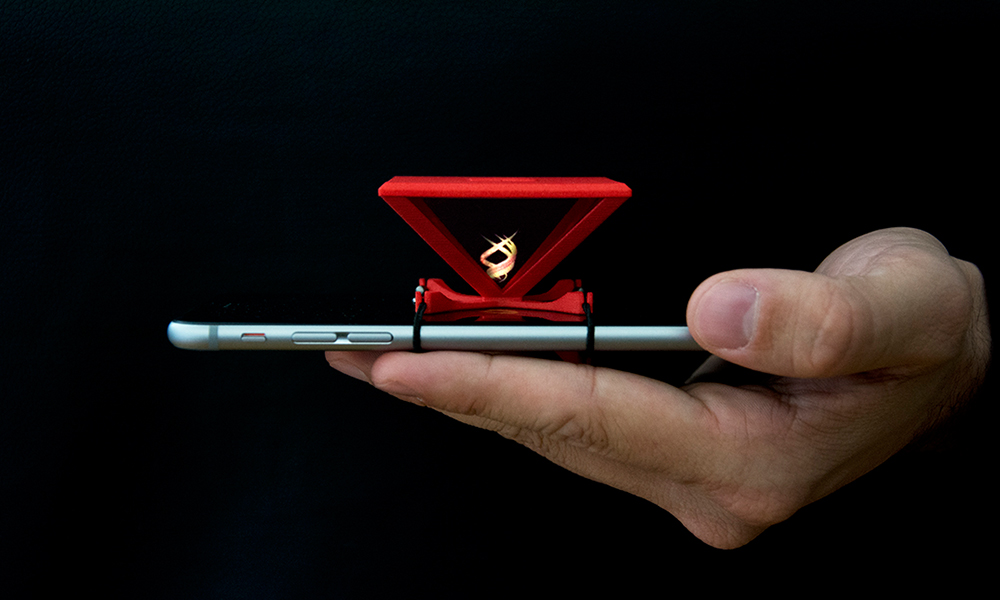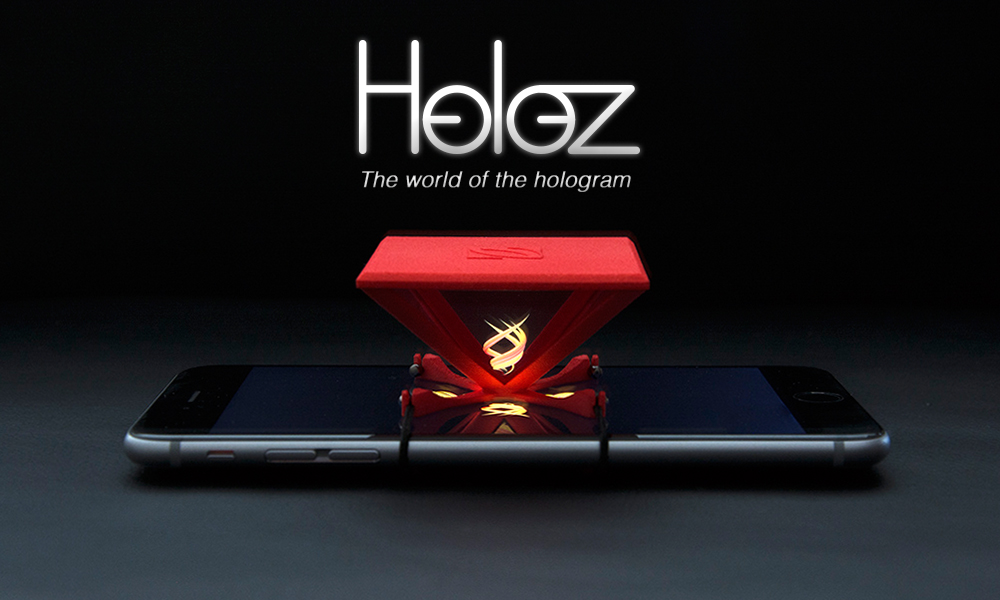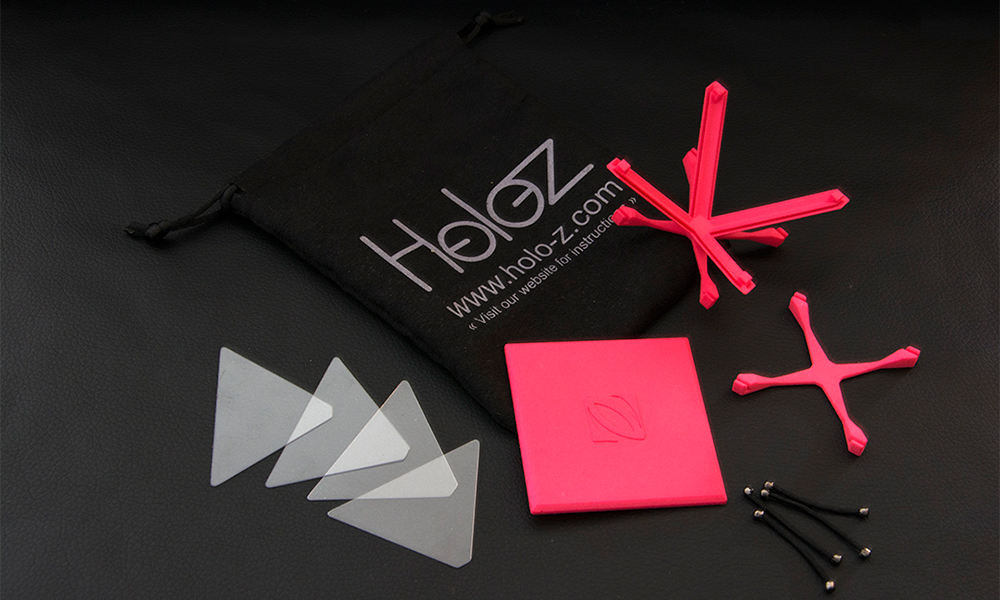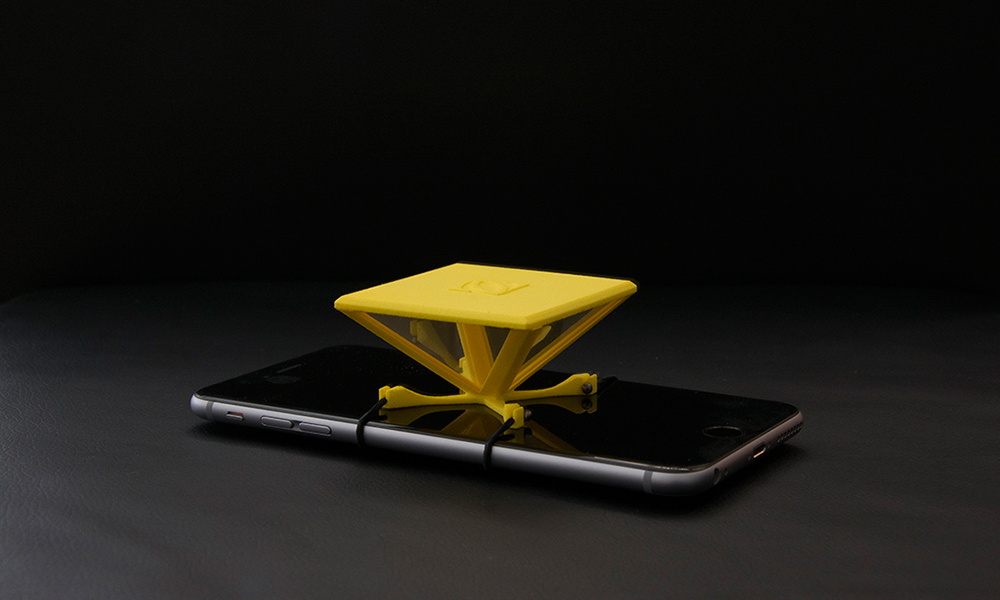How 3D printing helps starting businesses: the Holo-Z customer story
Posted By Hannah Bensoussan on Aug 2, 2016 | 0 comments
Holo-Z is a starting business which provides hologram supporting for various kinds of screens. They use Sculpteo’s service for 3D printing and delivery. We had an interview with Cyril Dieumegard, the company’s founder, and he told us about why he chose 3D printing, what it brought to him, how the concept-to-production process went, how his Sculpteo experience went, which difficulties he encountered and how he overcame them.
1. What’s the Holo-Z story?
It all started in 2014 when I discovered that some American makers were creating little holograms with their smartphones, using pieces of plastic to be cut in CD cases. The result was nice! But of fairly low quality. That’s when I decided to create an improved version of the system.
In the same period, I took business creation classes: I wanted to create a promotion company through new technologies, in particular 3D printing, but also holography and virtual reality (this company now exists under the name of Zblack: www.zblack.ch). It’s in that course that I met Jaime Mansilla, who works in luxury watchmaking in Geneva. We got along instantly and discussed our shared passion for 3D modeling.
Looking for new ideas, I thought: why not 3D print the holographic support? So I contacted Jaime Mansilla to collaborate with him for the creation of a printable high-quality STL file. We then created many prototypes before reaching the final version of the Holo-Z Phone!
2. Why did you choose to use 3D printing?
Reducing costs means not being controlled by investors
We chose 3D printing for a very simple reason: investment cost. When you start a company, raising funds is always a primordial issue, tightly linked with the control over your own company. I wanted to keep control over the company in order to progress at my own rhythm without pressure from investors. The first investment for 3D printing is almost null and it allows a really fast production. If I wanted to do the same thing with traditional plastic injection technics, I would have had to invest into a very expensive mold (between 30 000 and 50 000€).
Design and customization freedom
3D Printing also allows for great freedom in creation, edition, and customization by the client: when ordering on the Holo-Z online shop (a Sculpteo API), the clients can choose the color and material of each of the three parts.
3. Prototyping, production or both? What do you use 3D printing for?
At first, we thought of only using 3D printing for prototyping, but very quickly, considering the quality of the printing, we thought production could work too!
Even if the price remains quite a stumbling block, I think investing into an innovative manufacturing process always remains an outstanding advantage: the price will decrease and the quality will increase.
Besides, we started with a small number of units, 2000, which means 3D printing was still interesting price wise.
(See our article and free ebook about when to choose additive or traditional manufacturing for production)
4. From prototype to production: which obstacles did you encounter and how were they overcome?
a. 3D modeling
Designing wasn’t the most difficult part, as I am used to working with Cinema4D, the software I used for the first tests. Then with the intervention of Jaime we could design on SolidWorks, which adapts much better into a production quality STL.
b. To use a personal 3D printer or a 3D printing service?
I was then naive enough to think that my personal 3D printer would be enough to make the prototypes: we started by doing production tests with PLA plastic on my WitBox. But even though my WitBox is of good quality, it can’t print in such small dimensions and with so many details. That’s how I naturally turned to Sculpteo to produce our prototypes.
(See our infographic about whether you should use your own 3D printer or a 3D printing service)
c. Trial and error: taking the materials and the technology into account
It was quite long, several months, but incredibly exciting: each idea replaced the previous one, each time with the suspense of “is it going to work?”
Even if everything is fine with the 3D file, you have to take into account the plastic’s reality, its resistance and strength. We first used Sculpteo’s powder technology and very quickly, the resolution was good enough for the parts to fit together. However, gaps of 0.1mm make a difference. The margins were difficult to calculate, which is why we had to make several versions before having one that worked, still without being the final version. We needed 12 versions to reach the one we have actually, which is both practical and functional.
(If you want to learn about material restrictions for 3D printing, check out our materials page.)
d. Constantly questioning your design to provide the best quality
You need to constantly go further when conceiving a product, and ask yourself “How will the client use this?”, “Is this really practical?”, “Wouldn’t a bit of extra margin be useful?” Even today, I could still change the product’s design, it’s endless, but you need to keep this dynamic, in order to provide the best possible quality.
5. How was your Sculpteo experience? Which ones of our tools and features did you use?
We explored Sculpteo’s features through and through! API, manufacturing processes, prices, materials, etc… The most useful tool is, without a doubt, the solidity check that indicates red zones (fragile zones) and green zones (strong zones), which you can’t see through the modeling software alone. It’s reassuring to know the tool is adapted to the material we’re using.
I had used Sculpteo frequently before Holo-Z: I make promotional objects. I always found the service and the quality impeccable, and I appreciate the simplicity of use of the platform. That’s what led me to think “Why not go further with Sculpteo?” We then contacted Sculpteo, not knowing if we would be taken seriously. It’s always difficult when we’re starting to go and see a giant like Sculpteo to pitch a project. The project received a warm welcome, an immediate interest. We then were lucky enough to come and present it in the Sculpteo offices near Paris. We could meet with the team, and discuss the project face to face.
(Learn about our tools to help with your 3D printing)
6. Do you plan on using 3D printing again?
Yes, we are planning an iPad version of the Holo-Z, as well as a TV version for much larger screens. I also have other ongoing projects in which 3D printing could absolutely have a role to play.
7. Which advice would you give to someone starting out with direct manufacturing?
To think well about the goal of their use of 3D printing: even though 3D printing is a fantastic technology, it remains a tool before anything else, and, as all tools, it is more or less adapted to different uses. That’s why it’s primordial to explore all the possibilities in order to choose the most adapted creation mean.
Sculpteo’s idea to launch a laser cutting offer is excellent, and will allow to provide clients one more mean of production to choose from! It’s key to keep moving in this direction and offer a larger range of creation tools to clients.
To sum up: what to learn from Holo-Z’s testimony
1. Since it doesn’t require any investment in molds or machines, using a 3D printing service reduces costs for prototyping and small batches, therefore reducing considerably the initial investment. This means a lesser need to raise funds, the possibility to raise them on your own and not having to answer to investors, which gives the possibility to keep control over your business choices. This is often key for starting businesses.
2. 3D printing also allows for great design freedom and customization for your customers, without any added cost, which is impossible with traditional manufacturing.
3. It’s important to know the characteristics and restrictions of the materials you wish to use, in order to optimize the production process (it will probably need some trial and error). 3D printing is a production tool, and as all tools it has its advantages and drawbacks, and is not fit for all uses: make sure you know what you wish to do with it.


 Connect with Google
Connect with Google Connect with Facebook
Connect with Facebook


